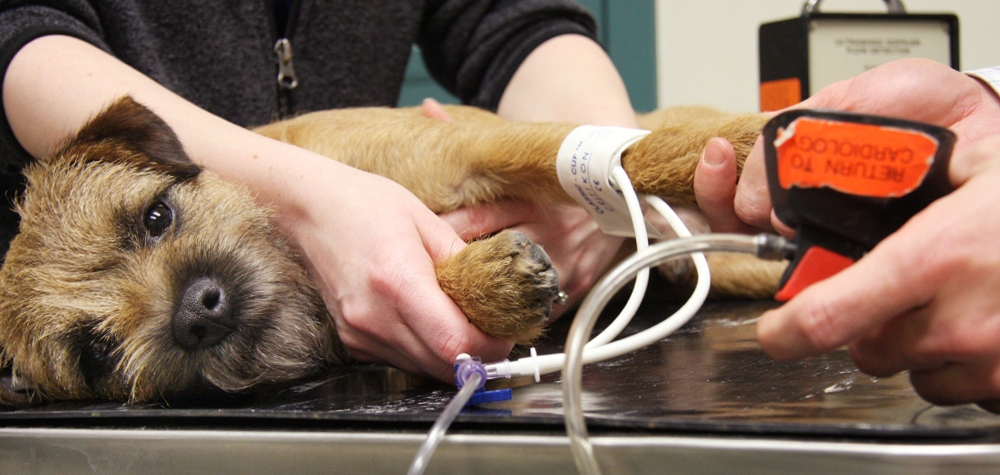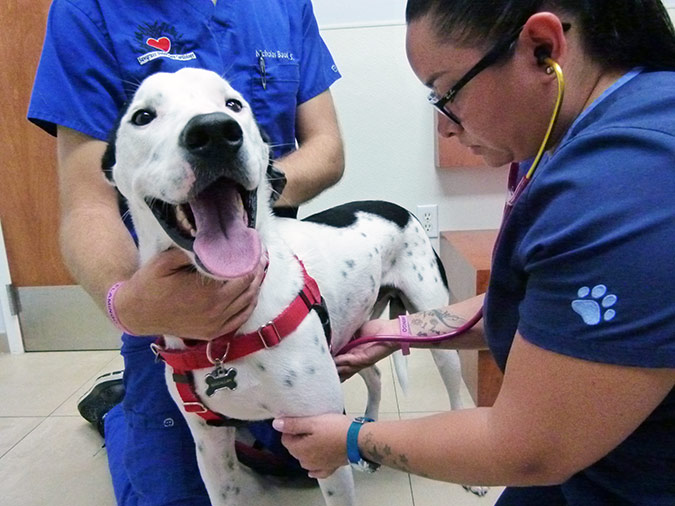The Duty of Ultrasound and CT Check in Modern Vet Practices: Insights From Experienced Professionals
In modern vet practices, ultrasound and CT scans substantially boost analysis capacities. These imaging methods offer critical understandings right into animal health, leading therapy decisions. Experienced specialists recognize the unique advantages of each modality. Ultrasound offers real-time evaluations, while CT checks provide elaborate anatomical details. Understanding their duties and applications elevates crucial concerns concerning their influence on person outcomes and the future of vet diagnostics. What insights can be gotten from their combined usage?
Comprehending Ultrasound in Vet Medicine
Ultrasound is a vital analysis tool in veterinary medicine, providing a non-invasive technique to imagine internal structures. This imaging technique employs high-frequency sound waves to develop real-time photos of body organs and tissues, permitting veterinarians to examine problems without surgical intervention. Typical applications consist of assessing the heart, liver, kidneys, and reproductive body organs, along with checking pregnancies.The procedure is reasonably fast and can be done in different settings, making it an accessible option for vets. Unlike radiography, ultrasound supplies comprehensive information concerning soft cells and blood circulation, which is crucial for accurate diagnoses.Veterinary experts count on ultrasound to detect abnormalities such as tumors, cysts, and fluid accumulation. Its capacity to assist biopsies and other treatments even more boosts its utility in scientific technique. By providing a safe and efficient method to check out internal makeup, ultrasound has actually come to be a keystone of modern-day vet diagnostics.
The Benefits of CT Checks for Animal Diagnostics
CT scans deal considerable benefits in veterinary diagnostics by giving improved accuracy in recognizing inner conditions (Board Certified Veterinary Cardiologist). As a non-invasive imaging technique, they assure the safety and convenience of pets throughout evaluations. Furthermore, CT checks promote a detailed assessment of interior frameworks, enabling for a lot more reliable treatment preparation
Enhanced Analysis Accuracy
Improvements in imaging modern technology have substantially improved diagnostic precision in veterinary medication, especially with using CT scans. These scans offer in-depth cross-sectional photos of a pet's internal structures, allowing veterinarians to recognize irregularities with accuracy. The high resolution and three-dimensional capabilities of CT imaging assist in the discovery of problems such as growths, cracks, and interior bleeding that could be missed out on with traditional imaging approaches. Furthermore, CT scans can help in pre-surgical planning by using a detailed view of physiological connections. This level of detail not just enhances the precision of medical diagnoses yet likewise aids in customizing reliable treatment strategies. Consequently, the combination of CT technology into vet methods is transforming the landscape of pet health care, enhancing results for people.
Non-Invasive Imaging Technique
The introduction of non-invasive imaging strategies has reinvented animal diagnostics, with CT scans emerging as a famous tool in veterinary techniques. These scans offer high-resolution, cross-sectional pictures of an animal's inner structures, permitting veterinarians to examine complicated conditions without the need for invasive procedures. The benefits of CT scans include their capacity to find lumps, fractures, and inner blood loss with exceptional precision. In addition, they promote the analysis of soft cells and organs, boosting analysis capabilities. The speed of CT scanning allows quick decision-making, which is important in emergency scenarios. By lessening stress and anxiety and pain for the pet, CT scans add to an extra humane approach to diagnostics, ultimately enhancing treatment results and progressing vet care.
Comprehensive Internal Assessment
A complete internal analysis is important for precise medical diagnosis and efficient treatment in veterinary medicine. CT checks deal considerable advantages hereof, supplying in-depth cross-sectional images of an animal's inner frameworks. This sophisticated imaging modality boosts visualization of complicated anatomical areas, enabling vets to recognize irregularities such as tumors, fractures, and inner blood loss with better accuracy. Additionally, CT scans assist in the evaluation of conditions that may be testing to identify with typical techniques. The speed and accuracy of CT imaging also add to prompt treatments, enhancing client results. As veterinary practices significantly include CT technology, the advantages of substantial interior assessments become evident, enhancing the value of this device in modern veterinary diagnostics.
Comparing Ultrasound and CT Imaging Techniques
While both ultrasound and CT imaging offer crucial functions in vet diagnostics, each method provides unique advantages and limitations that can affect clinical decision-making. Ultrasound is particularly valued for its real-time imaging capabilities, permitting veterinarians to observe vibrant physical processes. This strategy is non-invasive, portable, and does not include ionizing radiation, making it a more secure option for both medical professionals and animals. However, ultrasound might have restrictions in imagining particular anatomical frameworks or deep tissues.Conversely, CT imaging gives in-depth cross-sectional views of the body, permitting precise localization of irregularities. It masters examining complicated body organs and structures, especially in the thorax and abdomen. CT scans require sedation or anesthetic in many situations and entail exposure to ionizing radiation. Eventually, the selection between ultrasound and CT relies on the details professional situation, the location of rate of interest, and the necessity of the analysis needs.
Situation Studies: Effective Diagnoses Via Imaging
Case studies show the significant enhancements in analysis accuracy attained via advanced imaging modern technologies like ultrasound and CT scans in veterinary practices. These improvements not just boost the detection of different conditions however additionally facilitate timely and reliable therapy plans. Assessing particular situations can highlight the transformative effect of these imaging techniques on vet medicine.
Analysis Accuracy Improvements

Imaging Modern Technology Advancements
As veterinary imaging technology remains to develop, its influence on analysis capabilities ends up being progressively apparent. Recent study highlight the successful application of sophisticated ultrasound and CT scan methods in determining intricate problems. A vet center used high-resolution CT scans to identify a rare form of lung cancer in a pet dog, which traditional imaging had missed. Likewise, an ultrasound evaluation revealed a stomach mass in a pet cat, motivating timely surgical treatment and a positive outcome. These innovations not just improve diagnostic accuracy however additionally enable vets to develop targeted therapy plans. By leveraging sophisticated imaging technologies, veterinary specialists are noticeably boosting client treatment, resulting in extra effective management of different health conditions in pets.
The Function of Imaging in Emergency Situation Veterinary Treatment
Imaging plays a crucial function in emergency situation veterinary care, giving veterinarians with crucial details required to make rapid, informed choices. In urgent circumstances, techniques like ultrasound and CT scans allow practitioners to promptly evaluate a family pet's inner frameworks, identifying critical conditions such as interior blood loss, fractures, or organ irregularities. These imaging modalities permit for real-time evaluations, assisting in prompt treatments that can be life-saving. Ultrasound is indispensable for evaluating soft tissue injuries and conditions like liquid build-up, while CT checks deal comprehensive photos of intricate physiological frameworks, necessary for detecting injury instances. The speed and accuracy of these imaging techniques enhance the vet's capability to create efficient treatment strategies, guaranteeing the finest possible results for their individuals. Subsequently, the assimilation of sophisticated imaging modern technologies into emergency veterinary practices is not just advantageous however progressively needed, as it boosts diagnostic abilities and boosts total animal treatment during defining moments.
Training and Knowledge in Veterinary Imaging
Although sophisticated imaging techniques such as ultrasound and CT scans are necessary for effective vet care, the successful execution of these innovations heavily depends upon the training and expertise of veterinary specialists. Skillful use imaging tools needs thorough understanding of composition, pathology, and the concepts underlying each technique. Veterinary specialists should undertake specific training to precisely analyze imaging outcomes, which is essential for identifying problems and preparing treatment.Certifications and proceeding education and learning in veterinary imaging enhance the skills of professionals, enabling them to remain upgraded with technical innovations. Collaboration between vets and radiologists often results in boosted analysis precision, as experts can supply understandings right into intricate instances. Furthermore, functional experience in managing imaging devices promotes confidence in its application. Eventually, the high quality of veterinary imaging services is straight associated to the degree of training and proficiency possessed by the professionals using these vital diagnostic devices.
Future Fads in Diagnostic Imaging for Animals
With the rapid improvements in innovation, veterinary analysis imaging is positioned for significant advancement in the coming years. Arising patterns indicate a change towards more portable and available imaging techniques, such as handheld ultrasound tools, which can improve field diagnostics. Additionally, the combination of synthetic intelligence is anticipated to transform image analysis, permitting for quicker and much more precise interpretations of results.Moreover, advancements in imp source 3D imaging techniques and calculated tomography will offer vets with more thorough views of pet composition, resulting in better therapy plans. Digital reality modern technology may also play a duty in surgical preparation and education, giving vets an unique viewpoint on complex cases.As telemedicine remains to grow, remote appointments assisted in by analysis imaging will come to be a lot more usual, enabling specialists to aid basic practitioners in real-time. Generally, these fads are readied to improve the performance official source and efficiency of vet treatment, ultimately enhancing animal results.
Often Asked Inquiries
How Much Do Ultrasound and CT Scans Cost in Veterinary Centers?
The costs of ultrasound and CT scans in vet clinics commonly range from $300 to $1,500, depending upon variables such as location, center kind, and details procedures required for the animal's medical diagnosis and therapy.

Exist Any Type Of Threats Connected With Ultrasound and CT Scans for Pet Dogs?
Ultrasound and CT scans usually posture very little dangers to pets. Nonetheless, possible issues consist of sedation responses and direct exposure to anesthetics. Cancer Veterinary Near Me. Vets very carefully evaluate each case to reduce any kind of risks related to these diagnostic treatments
How Lengthy Do Ultrasound and CT Procedures Normally Take?
Ultrasound treatments generally take about 30 mins to an hour, depending on the intricacy. CT scans, being even more comprehensive, generally require thirty minutes to 90 minutes, including prep work and healing time for the animal.
Can All Veterinarians Perform Ultrasounds and CT Scans?
Not all veterinarians can execute ultrasounds and CT scans. Specialized training and certification are typically called for to assure proficiency in these advanced imaging techniques, which may limit their accessibility to veterinarians with additional certifications and sources.
What Kinds Of Pets Benefit Most From These Imaging Techniques?
Certain pet species, specifically pets and cats, advantage considerably from ultrasound and CT scans. These imaging strategies enhance diagnostic precision for problems like lumps, inner injuries, and body organ abnormalities, resulting in enhanced therapy end results and patient care. The high resolution and three-dimensional abilities of CT imaging facilitate the detection of conditions such as tumors, fractures, and interior blood loss that may be missed with typical imaging approaches. Instance researches show the considerable renovations in analysis precision achieved via sophisticated imaging technologies like ultrasound and CT scans in veterinary methods. Improving analysis accuracy in vet techniques has been substantially assisted by developments in imaging technologies such as ultrasound and CT scans. Innovative imaging techniques such as ultrasound and CT scans are necessary for reliable veterinary treatment, the successful application of these technologies greatly depends on the training and proficiency of veterinary professionals. Veterinary specialists have to undertake specialized training to properly translate imaging outcomes, which is essential for detecting problems and planning treatment.Certifications and continuing education and learning in vet imaging enhance the abilities of practitioners, enabling them to remain upgraded with technological developments.